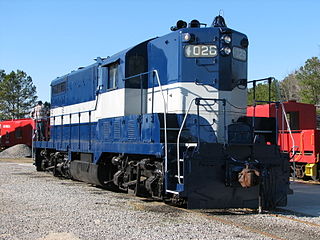Related Research Articles

The Georgia Railroad and Banking Company also seen as "GARR", was a historic railroad and banking company that operated in the U.S. state of Georgia. In 1967 it reported 833 million revenue-ton-miles of freight and 3 million passenger-miles; at the end of the year it operated 331 miles (533 km) of road and 510 miles (820 km) of track.

The Central of Georgia Railway started as the Central Rail Road and Canal Company in 1833. As a way to better attract investment capital, the railroad changed its name to Central Rail Road and Banking Company of Georgia. This railroad was constructed to join the Macon and Western Railroad at Macon, Georgia, in the United States, and run to Savannah. This created a rail link from Chattanooga, on the Tennessee River, to seaports on the Atlantic Ocean. It took from 1837 to 1843 to build the railroad from Savannah to the eastern bank of the Ocmulgee River at Macon; a bridge into the city was not built until 1851.
The Augusta and Knoxville Railroad (A&K) was a railroad company that operated on 66 miles (106 km) of track between Augusta, Georgia, and Greenwood, South Carolina, from 1882 to 1886. It was merged with three other companies to form the Port Royal and Western Carolina Railway, which was reorganized in 1896 as the Charleston and Western Carolina Railway.
Augusta and Savannah Railroad was incorporated in Georgia by special act of the General Assembly, approved December 31, 1838, as Augusta and Waynesboro Railroad Company. The name was changed to Augusta and Savannah Railroad on February 16, 1856.
The Augusta and Summerville Railroad is a railroad in Georgia, United States.
The Charleston and Western Carolina Railway (C&WC) was formed in 1896 to operate the lines of the former Port Royal and Augusta Railway (PR&A) and the Port Royal and Western Carolina Railway (PR&WC). The PR&A and PR&WC had originally been part of the Central of Georgia Railroad but the South Carolina Legislature had forced the railroad to give up the subsidiary lines. The Atlantic Coast Line Railroad (ACL) took over the C&WC in 1897 but operated it as a subsidiary until 1959 when the ACL fully absorbed it. Much of the original system is still in use by ACL successor CSX Transportation.

The Union Station built in 1930 in Atlanta was the smaller of two principal train stations in downtown, Terminal Station being the other. It was the third "union station" or "union depot", succeeding the 1853 station, burned in mid-November 1864 when Federal forces left Atlanta for the March to the Sea, and the 1871 station.

The Carolina Piedmont Railroad is a class III railroad and subsidiary of Genesee & Wyoming Inc. operating in the Upstate region of South Carolina. From an interchange with CSX Transportation at Laurens the railroad runs 34 miles (55 km) to the northwest, terminating at East Greenville.

Riverwalk Augusta is a city park along the Savannah River in downtown Augusta, in the U.S. state of Georgia. The park is alongside and on top of Augusta's levee. It extends from the 13th Street Bridge to the Gordon Highway bridge. Sites along the Riverwalk include St. Paul's Episcopal Church, Georgia Cyber Center, and the Morris Museum of Art.
The McCormick Subdivision is a railroad line owned and operated by CSX Transportation in the U.S. states of Georgia and South Carolina. The line runs from Augusta, Georgia, to Greenwood, South Carolina, for a distance of 62.8 miles (101.1 km). At its south end the line continues north from the Augusta Subdivision and at its north end the line continues north as the Monroe Subdivision.
The Port Royal and Augusta Railway was a South Carolina railroad that existed in the latter half of the 19th century.
The Port Royal and Western Carolina Railway (PR&WC) was a railroad company in the southern United States that operated on 229 miles (369 km) of 4 ft 9 in gauge track. It was formed in 1886 by the merger of the Augusta and Knoxville Railroad, Greenwood, Laurens and Spartanburg Railroad, Savannah Valley Railroad and the Greenville and Laurens Railroad, which then joined with Port Royal and Augusta Railway.
The Port Royal Railroad was a South Carolina railroad that was constructed following the American Civil War. The line was chartered in 1856 but wasn't built until 1870. By 1871, it ran from Port Royal, South Carolina, to Yemassee, South Carolina. It was extended to Augusta, Georgia in 1873. That same year, the company declared bankruptcy and was sold to the new Port Royal and Augusta Railway in 1878.
The Greenwood, Laurens and Spartanburg Railroad was a South Carolina railroad company begun after Reconstruction.
The Raleigh and Augusta Air Line Railroad was a North Carolina railroad that operated in the second half of the 19th century.
The Augusta Subdivision is a railroad line owned by CSX Transportation in the U.S. states of Georgia and South Carolina. The line runs from Augusta, Georgia, to Yemassee, South Carolina, for a total of 87.7 miles (141.1 km). At its north end it continues south from the McCormick Subdivision and at its south end it continues south as the Charleston Subdivision.
Augusta Union Station was a train depot in Augusta, Georgia at 525 8th Street, serving trains from its opening in 1903 to its closing in 1968. The Spanish Renaissance styled building was in central Augusta at Barrett Square, five blocks from the banks of the Savannah River.
References
- ↑ Thomas, Henry W. (1895). Digest of the Railroad Laws of Georgia. Atlanta, GA: Franklin Printing and Publishing Co. p. 283 – via Google Books.